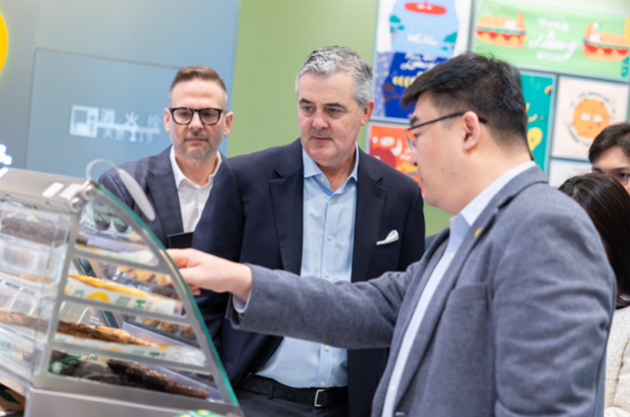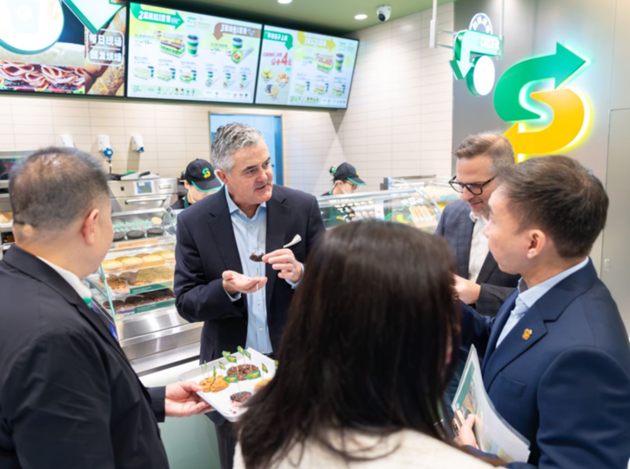Recently, major international catering giants have seen significant adjustments: On November 4, Starbucks announced the sale of its China business equity; on November 10, Burger King's China business also embarked on the path of selling equity. The moves of these two leading brands reflect common challenges faced by international catering companies—rising costs, intensifying competition, and an urgent need for localization.
At this critical juncture where foreign brands are adjusting their China market strategies, a veteran in the catering industry—Jonathan Fitzpatrick, global CEO of Subway—suddenly appeared in Shanghai. He was formerly a senior executive at Burger King, leading the brand's largest-ever menu reform. In July this year, Fitzpatrick officially took the helm of Subway.
Subway holds an important position in the global F&B market. Its number of stores once surpassed KFC, topping the fast-food industry, and it still has over 35,000 stores today.
Fitzpatrick's schedule in China was packed. Without time to adjust for jet lag, he tirelessly visited multiple Subway stores and made special trips to competitor outlets like KFC, McDonald's, and Starbucks. Amidst industry transformation, what strategic intent lies behind Fitzpatrick's "surprise visit" to China?

Fitzpatrick has an exclusive interview with NBD Photo/Cong Sen (NBD)
"China is our fastest-growing market globally." Recently, in the Subway China office adjacent to the Huangpu River, Fitzpatrick accepted an exclusive interview with National Business Daily (NBD), sharing his feelings about returning to China after more than 20 years. "This trip has allowed me to see many best practices in digitalization, marketing, menu innovation, and even packaging, which I will take back and share with the global team."
However, against the backdrop of slowing growth in the global catering industry and equity changes among competitors, can Subway truly achieve its goal of counter-trend expansion by opening 4,000 stores in China? What new challenges are foreign catering brands facing in the Chinese market?
On "the fastest Chinese speed globally": Empowering the local team, expanding stores in China to over 1,000 in just over two years
Afternoon sunlight streamed through the floor-to-ceiling windows, illuminating Fitzpatrick's face. Though slightly tired, his eyes were sharp. After politely greeting the reporter, he quickly engaged in the interview.
"This city is one of the most dynamic and exciting metropolises I've seen in my travels around the world," Fitzpatrick said. He dedicated his entire morning to frontline market research, visiting Subway stores in different districts of Shanghai and inspecting competitor stores like KFC and McDonald's. He carefully observed every detail, from store layouts and customer behavior to product displays and variety.
Fitzpatrick stated frankly that competition in the catering industry is normal globally.
"The competitive products we see here in Shanghai, we've encountered them in many countries before." Speaking about his intuitive impressions from this China trip, Fitzpatrick couldn't hide his excitement, "I am extremely optimistic that Subway has a chance to thrive in the China market, whether in Shanghai, Beijing, Chengdu, or Hangzhou."
Subway was founded in 1965, specializing in submarines and headquartered in the US. At its peak in 2010, the company had approximately 45,000 stores across 112 countries and regions. Global sales reached $18 billion in 2012, but subsequently entered a decade-long decline. As revenue fell, Subway began to "slim down." According to Restaurant Business, a media in catering industry, the company closed over 2,300 stores in the US market between 2016 and 2018. Following its acquisition by a private equity firm in 2023, Subway embarked on a comprehensive restructuring.
"We currently operate over 35,000 stores in more than 90 countries and regions worldwide," Fitzpatrick told the reporter.

Fitzpatrick (center) checks ingredients at a Subway restaurant in China
Photo/Cong Sen (NBD)
Although Subway's store count remains large, it is nearly 10,000 stores fewer than its peak. During the restructuring, the speed of store openings and profitability in the Chinese market gave Fitzpatrick hope. In 2024, Subway China opened 220 new directly-operated stores, setting a record for annual store openings since entering China 30 years ago. It was revealed that in 2024, the average revenue per Subway store surged, with total revenue exceeding 1 billion yuan.
Behind the explosive growth of Subway's China market is its choice to seek local partners. Similar to the current moves by Starbucks and Burger King, which handed majority stakes in their China businesses to local capital, attempting to trade "control" for growth through joint ventures.
As early as June 2023, Subway signed a general franchise agreement with Shanghai Furuishi Foods Enterprise Development Co., Ltd. (FRS). FRS obtained the exclusive rights to manage and develop all Subway stores in the mainland China, planning to open 4,000 restaurants within the next 20 years and expand Subway's market size in China by more than sevenfold. The agreement is regarded as "one of the largest franchise agreements in the entire fast-food chain industry." Notably, to advance the expansion plan, Subway China also recruited Zhu Fuqiang, the former CEO of Burger King China.
Pioneering ahead of competitors, Subway has rapidly expanded in the China market through direct-operated stores. Data shows that at the beginning of 2023, among its 535 stores in China, only 5 were directly operated. Now, the total number of its stores in China has exceeded 1,000.
"In just over two years, we have opened more than 400 new stores in China, a growth rate that is arguably the fastest in the world." Fitzpatrick expressed pleasant surprise at this, adding that the profitability of the new stores is also very good. "Although we are also growing rapidly in places like Brazil, China has both operational capabilities and a large number of untapped areas. This combination gives us more opportunities."
With 25 years of experience in the franchise industry, Fitzpatrick revealed to the reporter that the United States remains Subway's largest single market, but as the most mature market, its growth potential is relatively limited. "Our future growth will mainly come from international markets, and among all overseas markets, China is the most important."
Discussing the surrounding "KFCs and others": Breaking Free From the fried food “involution”, leveraging breakfast to conquer time slot barriers and reinvent competitiveness
Fitzpatrick told the reporter that when he stood by the window of Subway China's office and looked out, he could take in the bustling scenes on both sides of the Huangpu River, but he also deeply felt that the competition in western-style catering here was becoming increasingly fierce.
In 2024, McDonald's China stores reached 6,820, with an additional 1,000 expected to be added by 2025. By the end of September 2025, KFC's stores in China exceeded 12,000. Currently, Burger King has approximately 1,250 stores in China, while the local brand Tastine's store count has surged to nearly 9,000. In comparison, Subway, although having surpassed the 1,000-store milestone in China, still lags behind its competitors in both quantity and brand presence.
Facing fierce market competition, how to continue to leap forward from 1,000 stores has become a major challenge Fitzpatrick hoped to tackle during his China trip, as Subway has just achieved phased growth.
"One of the core differences between our market in China and those in Europe and America is the level of brand awareness," Fitzpatrick said frankly. Although Subway has been in China for 30 years, the real rapid development has occurred in the past three years. In his view, the core challenge Subway faces is: "How to maintain the connection between the brand and the times, constantly innovate the menu, and ensure people consistently recognize us as a brand that is 'fresh, healthy, and leaves no burden after eating.'"

Fitzpatrick (second from left) and his entourage try out a new product developed by Subway China.
Photo/Cong Sen (NBD)
To tackle the challenges of brand recognition and localization, Subway began to focus on menu innovation. Fitzpatrick found that Chinese consumers attach great importance to breakfast, which was once a weak point in Subway's business.
"A few years ago, breakfast was far from being the focus of our business in China. But when the local team introduced high-quality coffee and breakfast sandwiches with diverse flavors, our breakfast sales have now increased significantly," he said, using breakfast as an example to illustrate the importance of menu innovation. "Subway makes sandwiches, but the flavors of sandwiches can vary endlessly. We can 'create' flavors closer to those of Chinese consumers, rather than simply copying menus from other countries."
In September this year, Subway attempted to incorporate Beijing's famous dishes like ‘Zizi’ barbecue into its products, marking another breakthrough in the brand's localization. This brings to mind KFC's efforts to cater to Chinese tastes: introducing crayfish, braised dishes, and even launching regional products like fried sauce noodles and hot dry noodles, which successfully won over a large number of Chinese consumers.
Aiming to Leverage China Experience for Global Benefit: Capturing Gen Z Mindshare, Digitalization is the Second Battlefield Beyond the Menu
Regarding competing for young consumer groups, Fitzpatrick also has clear ideas.
"Young customers are crucial to us," Fitzpatrick said. "If we can turn them into regulars with dining habits and trust, we can keep them for the long haul." Today's young people value good food, freshness and no fuss, which is a chance for Subway.
Beyond menu innovation and store layout optimization, Fitzpatrick emphasizes that digitalization is pivotal in engaging younger consumers. "We are fully embracing digital technologies," he noted, explaining how the brand's comprehensive digital integration is continuously enhancing operational efficiency and customer experience.

Foreign executives including Fitzpatrick (center) scan QR codes to place online orders
Photo/Cong Sen (NBD)
A pressing challenge is the sluggish growth faced by global restaurant chains. Data released by Technomic, a professional organization specializing in the foodservice industry, for the 2024 Top 500 chain restaurants in the US showed that the total revenue of the 500 companies, including Starbucks, McDonald's, and KFC, increased by only 3.1% compared to the previous year, the lowest industry level in nearly a decade.
Against such an industry backdrop, is Subway's choice for global expansion, especially in the Chinese market, an opportunity or an adventure?
"Many competitors focus on greasy and fried foods that leave you drowsy after eating. We specialize in fresh ingredients and customizable sandwiches. Customers can enjoy delicious meals without any guilt," Fitzpatrick believes Subway's core competitive advantage lies in its differentiated positioning.
And this differentiated positioning can support the brand to continue to "spread".
Specifically for the China market, Fitzpatrick said: "We currently have over 1,000 stores here and are making a full sprint toward the first milestone of '4,000 stores'. My greatest dream is to one day celebrate the opening of the 10,000th store here with everyone."
It is worth noting that the reporter learned that Subway has already planned an IPO, and it is not ruled out that it may be listed on NASDAQ or A-shares or Hong Kong stocks in the future. This also makes the performance of the China market more critical, becoming an important support for the valuation of the brand. Regarding the current revenue share of the China market in Subway and future expectations, Fitzpatrick did not disclose, but he said, "The influence of China on the Subway brand will continue to expand in the future."
Outside of work, Fitzpatrick's life is simple and pure: "My greatest hobby is spending as much time as possible with my family." And when it comes to work, he never stops. After his trip to China, the next stop is South Korea.
From China to South Korea, from the Asia-Pacific to the global market, Fitzpatrick said that Subway's practices in the Chinese market not only provided performance growth for the company but also became a transformation model for other global markets. He will take the experience gained from China to drive Subway's global transformation. "During this trip to China, I saw many best practices in digitalization, marketing, menu innovation, and even packaging. I will bring them back to share with the global team."


 川公网安备 51019002001991号
川公网安备 51019002001991号





